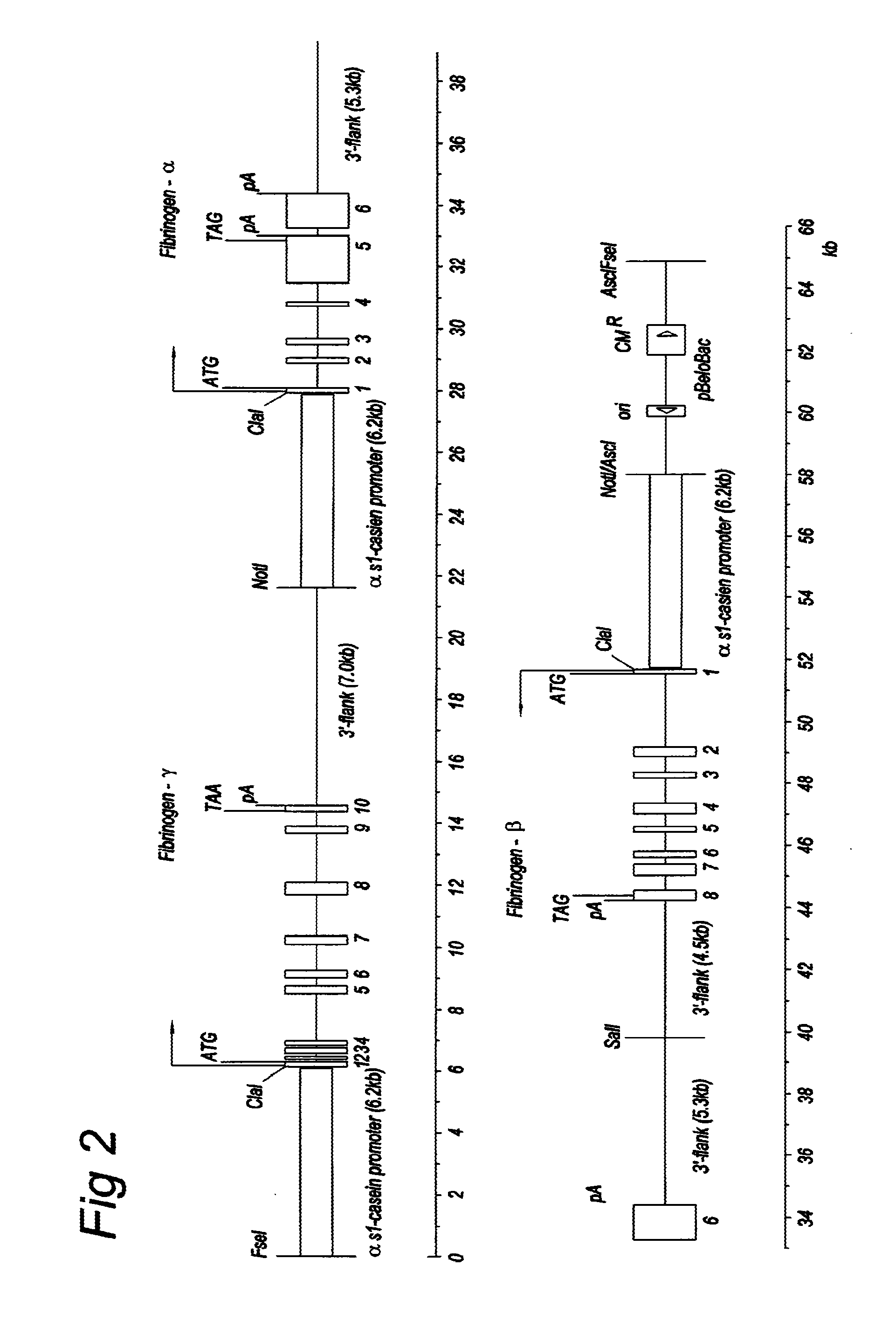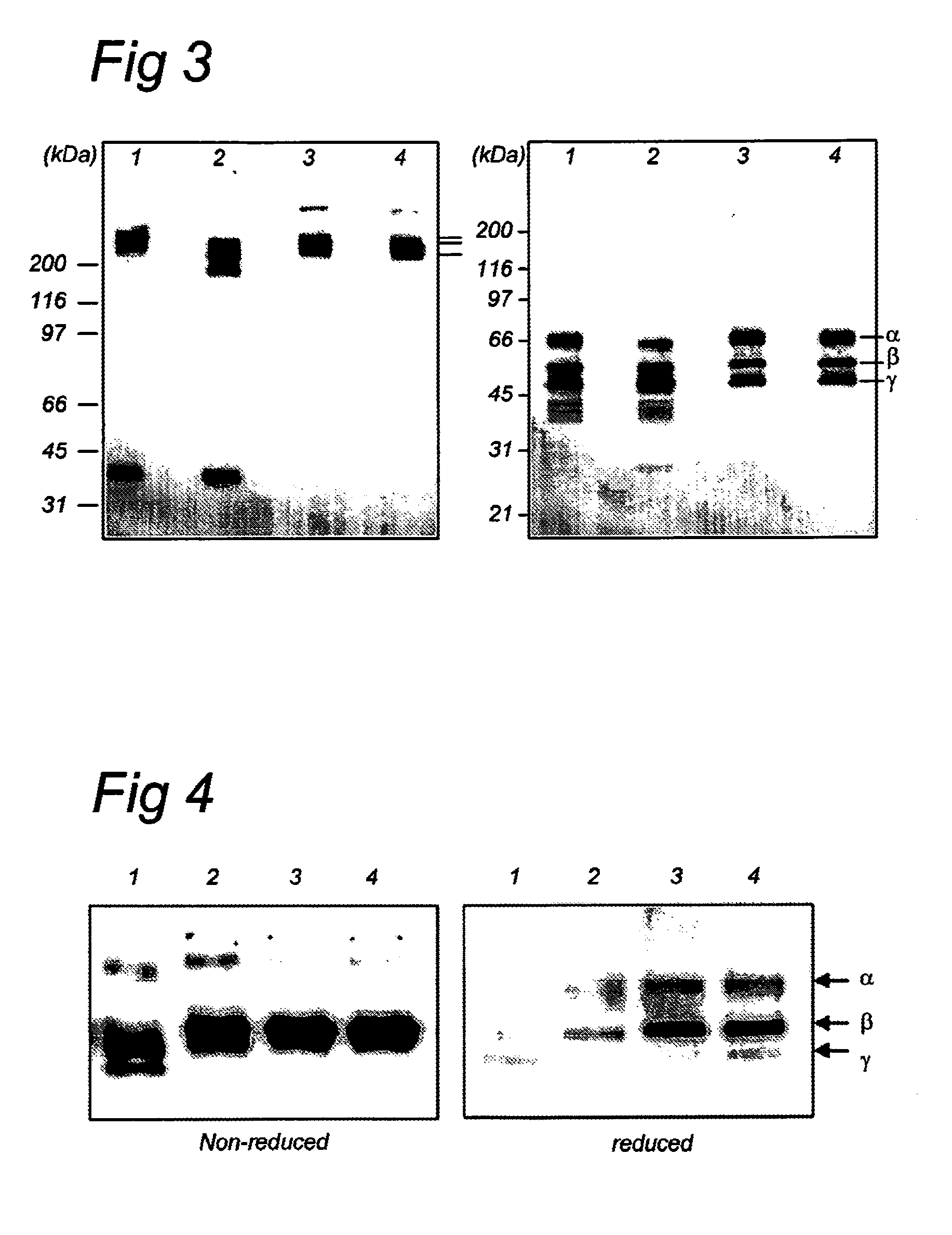Treatment of bleeding with low half-life fibrinogen
a fibrinogen and half-life technology, applied in the field of treatment of bleeding with low half-life fibrinogen, can solve the problems of bleeding as a result of organ failure, bleeding is a result of trauma, bleeding is a result of bleeding, etc., and achieve the effect of improving the side effects profile and improving the efficacy
- Summary
- Abstract
- Description
- Claims
- Application Information
AI Technical Summary
Benefits of technology
Problems solved by technology
Method used
Image
Examples
example 1
Production of Recombinant Fibrinogen
[0066]FIG. 1 shows three genomic expression vectors were constructed containing the α-, β- or γ-gene under control of the αS1-casein promoter. FIG. 2 shows a further exemplary vector was generated by combining the three α-, β and γ-fibrinogen constructs in one vector (FIB3 construct). Transgenic cows have been generated from both types of vector. Expression levels have ranged from about 1-3 mg fibrinogen / ml milk in different lines.
example 2
Purification of Recombinant Fibrinogen from Bovine Milk
[0067]To compare recombinant fibrinogen (rh-Fbg) to natural human fibrinogen, both recombinant human fibrinogen, expressed in bovine milk, and human fibrinogen from human plasma has been purified via a similar purification process. For the purification of recombinant fibrinogen (rh-Fbg), milk production was hormonally induced in a transgenic cow (cow 204; Fay), collected twice a day and stored at below −18° C. until further processing. At the start of the purification, milk was thawed and caseins and fat were removed by high speed centrifugation. Next, ε-Amino-caproic acid (ε-ACA) was added to prevent degradation of the fibrinogen by various proteases present in milk and plasma and subsequently, the whey (milk without caseins and fat) was subjected to ethanol precipitation. The precipitate was collected by centrifugation, washed, dissolved and subjected to another ethanol precipitation step in the absence of c-ACA. Finally, the ...
example 3
Structural Characterization of Fibrinogen
[0068]Human plasma fibrinogen appears heterogeneous by SDS-polyacrylamide gel electrophoresis (SDS-PAGE) and other methods for separation of proteins by molecular size. Full size, undegraded fibrinogen has a molecular weight of 340 kD (HMW-fibrinogen) and accounts for approximately 50%-70% of total fibrinogen. A second degraded form with a molecular weight of 305 kD (LMW) accounts for about 20-40% of total fibrinogen and the residual amount is LMW′-fibrinogen with a molecular weight of 280 kD. The two degraded forms differ in their Act-chains i.e. the LMW misses one of the two Aα-chains, whereas both Aα-chains are lacking in the LMW′ form, Holm, 1985, Thromb Res 37:165. Both rh-Fbg and h-Fbg were analyzed by SDS-PAGE and revealed that rh-Fbg is very similar to purified h-Fbg (FIG. 3). Under non-reducing conditions and in the presence of ε-ACA, both rh-Fbg and h-Fbg display the three characteristic molecular weight bands (HMW, LMW and LMW′) of...
PUM
| Property | Measurement | Unit |
|---|---|---|
| Fraction | aaaaa | aaaaa |
| Time | aaaaa | aaaaa |
| Time | aaaaa | aaaaa |
Abstract
Description
Claims
Application Information
 Login to View More
Login to View More - R&D
- Intellectual Property
- Life Sciences
- Materials
- Tech Scout
- Unparalleled Data Quality
- Higher Quality Content
- 60% Fewer Hallucinations
Browse by: Latest US Patents, China's latest patents, Technical Efficacy Thesaurus, Application Domain, Technology Topic, Popular Technical Reports.
© 2025 PatSnap. All rights reserved.Legal|Privacy policy|Modern Slavery Act Transparency Statement|Sitemap|About US| Contact US: help@patsnap.com



